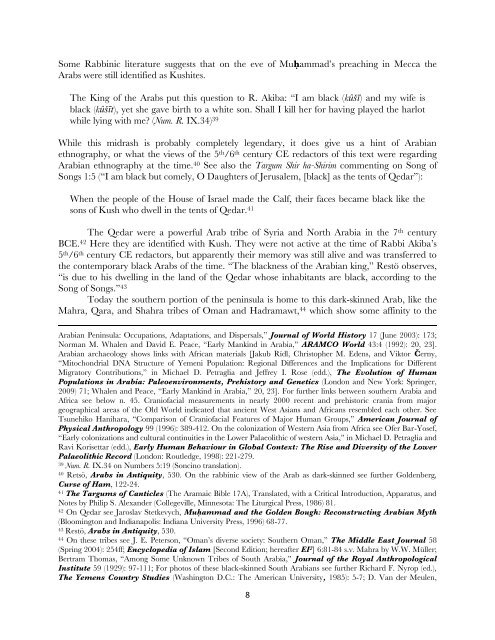Muhammad_Article.349.. - Dr. Wesley Muhammad
Muhammad_Article.349.. - Dr. Wesley Muhammad
Muhammad_Article.349.. - Dr. Wesley Muhammad
You also want an ePaper? Increase the reach of your titles
YUMPU automatically turns print PDFs into web optimized ePapers that Google loves.
Some Rabbinic literature suggests that on the eve of MuÈammad’s preaching in Mecca the<br />
Arabs were still identified as Kushites.<br />
The King of the Arabs put this question to R. Akiba: “I am black (kûšī) and my wife is<br />
black (kûšīt), yet she gave birth to a white son. Shall I kill her for having played the harlot<br />
while lying with me? (Num. R. IX.34) 39<br />
While this midrash is probably completely legendary, it does give us a hint of Arabian<br />
ethnography, or what the views of the 5 th /6 th century CE redactors of this text were regarding<br />
Arabian ethnography at the time. 40 See also the Targum Shir ha-Shirim commenting on Song of<br />
Songs 1:5 (“I am black but comely, O Daughters of Jerusalem, [black] as the tents of Qedar”):<br />
When the people of the House of Israel made the Calf, their faces became black like the<br />
sons of Kush who dwell in the tents of Qedar. 41<br />
The Qedar were a powerful Arab tribe of Syria and North Arabia in the 7 th century<br />
BCE. 42 Here they are identified with Kush. They were not active at the time of Rabbi Akiba’s<br />
5 th /6 th century CE redactors, but apparently their memory was still alive and was transferred to<br />
the contemporary black Arabs of the time. “The blackness of the Arabian king,” Restö observes,<br />
“is due to his dwelling in the land of the Qedar whose inhabitants are black, according to the<br />
Song of Songs.” 43<br />
Today the southern portion of the peninsula is home to this dark-skinned Arab, like the<br />
Mahra, Qara, and Shahra tribes of Oman and Hadramawt, 44 which show some affinity to the<br />
Arabian Peninsula: Occupations, Adaptations, and Dispersals,” Journal of World History 17 (June 2003): 173;<br />
Norman M. Whalen and David E. Peace, “Early Mankind in Arabia,” ARAMCO World 43:4 (1992): 20, 23].<br />
Arabian archaeology shows links with African materials [Jakub Rídl, Christopher M. Edens, and Viktor 1erny,<br />
“Mitochondrial DNA Structure of Yemeni Population: Regional Differences and the Implications for Different<br />
Migratory Contributions,” in Michael D. Petraglia and Jeffrey I. Rose (edd.), The Evolution of Human<br />
Populations in Arabia: Paleoenvironments, Prehistory and Genetics (London and New York: Springer,<br />
2009) 71; Whalen and Peace, “Early Mankind in Arabia,” 20, 23]. For further links between southern Arabia and<br />
Africa see below n. 45. Craniofacial measurements in nearly 2000 recent and prehistoric crania from major<br />
geographical areas of the Old World indicated that ancient West Asians and Africans resembled each other. See<br />
Tsunehiko Hanihara, “Comparison of Craniofacial Features of Major Human Groups,” American Journal of<br />
Physical Anthropology 99 (1996): 389-412. On the colonization of Western Asia from Africa see Ofer Bar-Yosef,<br />
“Early colonizations and cultural continuities in the Lower Palaeolithic of western Asia,” in Michael D. Petraglia and<br />
Ravi Korisettar (edd.), Early Human Behaviour in Global Context: The Rise and Diversity of the Lower<br />
Palaeolithic Record (London: Routledge, 1998): 221-279.<br />
39 Num. R. IX.34 on Numbers 5:19 (Soncino translation).<br />
40 Retsö, Arabs in Antiquity, 530. On the rabbinic view of the Arab as dark-skinned see further Goldenberg,<br />
Curse of Ham, 122-24.<br />
41 The Targums of Canticles (The Aramaic Bible 17A), Translated, with a Critical Introduction, Apparatus, and<br />
Notes by Philip S. Alexander (Collegeville, Minnesota: The Liturgical Press, 1986) 81.<br />
42 On Qedar see Jaroslav Stetkevych, MuÈammad and the Golden Bough: Reconstructing Arabian Myth<br />
(Bloomington and Indianapolis: Indiana University Press, 1996) 68-77.<br />
43 Restö, Arabs in Antiquity, 530.<br />
44 On these tribes see J. E. Peterson, “Oman’s diverse society: Southern Oman,” The Middle East Journal 58<br />
(Spring 2004): 254ff; Encyclopedia of Islam [Second Edition; hereafter EI 2 ] 6:81-84 s.v. Mahra by W.W. Müller;<br />
Bertram Thomas, “Among Some Unknown Tribes of South Arabia,” Journal of the Royal Anthropological<br />
Institute 59 (1929): 97-111; For photos of these black-skinned South Arabians see further Richard F. Nyrop (ed.),<br />
The Yemens Country Studies (Washington D.C.: The American University, 1985): 5-7; D. Van der Meulen,<br />
8

















